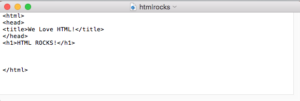The tags below should only appear on a webpage one time(along with their corresponding closing tag).
<html> – First tag.
</html> – Last tag.
<head>, </head> – Contains information for search engines and the title.
<title>, </title> – The title of a webpage appears on the top of a browser window.
<body>, </body> – The body tag identifies the main area of the webpage.
The following tags may appear multiple times on a webpage.
<p>, </p> – Paragraph tag. Skips a line above and below the paragraph.
<br> – Line break, send next item to the next line. Think of pressing return on keyboard. Notice there is no closing tag.
<hr> – Horizontal rule; inserts a line on webpage. Again, no closing tag.
<b>, </b> – Bold.
<i>, </i> – Italics.
<u>, </u> – Underline.
<h1>, </h1> – Heading one, largest heading.
<h6>, </h6> – Heading six, smallest heading.
<a href=”http://www.google.com”>Google</a> – Hyperlink to another website.
<a href=”page2.html”>See our second page</a> – Hyperlink to another page within your site.
<img src=”image1.jpg”> – Inserts a picture named image1.jpg. Image1.jpg has to be saved in the same folder as the html file you are editing.
<img src=”image2.jpg” height=300 width=300> – Inserts a photo named image2.jpg and sets the size.
<a href=”http://www.google.com”><img src=”image3.jpg></a> – Inserts photo image3 and makes it a link to Google.com.
.
